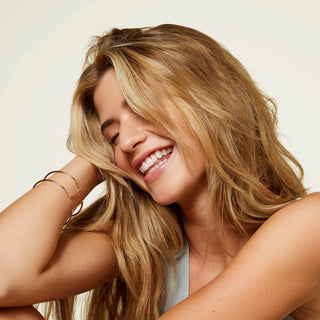We all have a type—a hair type, that is. Just as knowing your skin type is important for picking products that won’t irritate or clog your pores, understanding your hair type is essential for building a routine that will protect and nourish your strands.
Hair type and hair texture are often used interchangeably, but they’re actually two different things. Here, we break down how hair texture differs from hair type—and why knowing both can help you improve your routine.
What is hair type?
When people talk about hair type, they’re usually referring to the natural shape, or curl pattern, of your strands. The four main hair types are straight, wavy, curly and coily.

- Straight (type 1): This hair type is, well, straight. It lays flat from the roots to the ends with no wave or curl.
- Wavy (type 2): This hair has a gentle wave to it, usually forming an “s” shape. It's not as bouncy or tight as curly hair, but it has more texture than straight hair.
- Curly (type 3): Curly hair forms tighter ringlets, and it has more volume and bounce. Curls can range from loose to tight.
-
Coily (type 4): This is the tightest curl pattern, often forming small, defined coils or even zigzag shapes. It's dense, voluminous and may be more fragile.
These types don’t necessarily describe how thick, thin, dry or oily your hair is—they just categorize the overall pattern of your hair. And while curl pattern can certainly tell you a lot about how to care for your mane, we like to think about hair type a bit more holistically—taking into account porosity, density and texture, too!
What is hair texture?
Hair texture refers to the diameter, aka structure or thickness, of a single strand. It’s all about how your hair physically feels and how each strand behaves.

Get to know the three texture types:
- Fine: Fine hair is thin and delicate—you can barely feel it when you rub a single strand between two fingers. It’s prone to getting limp or flat since it doesn't hold volume as easily. It’s also more breakage-prone than coarser textures.
- Medium: Medium-textured hair is pretty balanced—not too thick, not too thin. It tends to hold styles well without being too heavy or too light.
-
Coarse: Coarse hair is thick and strong. It may feel rough to the touch and can hold a lot of volume. Coarse hair can sometimes be resistant to heat styling, but it’s often less susceptible to damage.
So, while hair type is all about the pattern of your strands (straight, wavy, curly, coily), texture is about how thick or thin each strand is and how it feels when you touch it.
Why are both important?
Understanding both your hair type and hair texture will help you narrow down the best care methods and products for your mane.
Say you have curly hair—you may be on a quest for better curl definition and less frizz. Knowing your hair texture will help you choose the right styling products and methods to achieve your #hairgoals.
For example, if your curls are fine in texture, you’ll want lightweight products (like our Air Dry Styler or Texturizing Sea Salt Spray) that will smooth and define without flattening or weighing down your hair. And since fine strands are delicate, you may also opt to heat-style less often to protect your curl pattern.
However, if your curls are coarse, heavier creams or oils (like our Leave-in Conditioner or Moisture Mask) will work better to smooth frizz and give your ringlets that plump, defined look. You may not need to wash your hair as often since coarser textures don’t get oily as fast as finer ones.











